Back in February, I asked my paid subscribers to suggest topics for me to investigate. I've been gradually working my way through the excellent list of questions I received, and it's now time to tackle the thorny issue of vitamin D supplementation.
To set the stage for this multi-part series, it's important to understand that low blood levels of vitamin D have been linked with increased risk of a host of health conditions, ranging from bone fractures to cardiovascular disease to autoimmune disorders to several types of cancer to schizophrenia to more frequent and severe bouts of respiratory tract infections including the flu and COVID-19. These associations led to the hypotheses that a) vitamin D deficiency plays a causal role in such health conditions, and b) that raising vitamin D levels through supplementation would prevent or alleviate them.
Yet randomised controlled trials of vitamin D supplementation have yielded disappointing results, with most studies finding no benefits, and a few detecting some harms. Advocates of vitamin D supplementation have countered that these trials were poorly designed, insufficient doses were given to raise participants’ levels into the optimum range, and dosages were not calibrated to participants' baseline vitamin D levels.
But is it possible that low levels of vitamin D are not a cause of ill-health, but a result of it? And does supplementing with vitamin D really address a deficiency state, or is it just like taking statins to lower cholesterol, or antihypertensives to reduce blood pressure - namely, manipulation of biomarkers without addressing the reasons why those biomarkers went awry in the first place?
In this first part of the vitamin D miniseries, I'm going to lay out the basics: what is vitamin D, and where does it come from? Bear with me as I'm going to go into quite a bit of detail, but I'm doing so for a very important purpose: I want to illustrate just how complex are the natural processes of production and regulation of vitamin D levels within the body, so that you can get some sense of how foolish it is to believe that we can hack this complex system by taking vitamin D supplements.
In subsequent parts, I'll delve into the biological activities of vitamin D, the many studies conducted on vitamin D supplementation, evidence of its possible adverse effects, the best way to optimise your vitamin D level, and what we can learn from the vitamin D saga.
Let's start by clearing up a major misconception:
Vitamin D is not a vitamin.
Whaaaat? But its name is vitamin D, right, so how can it not be a vitamin?
Here is the Oxford Reference definition of a vitamin:
But 'vitamin D' is synthesised by the body, and there is no dietary requirement for it at all - which is just as well, because very few foods contain it at any appreciable level, unless they've been fortified with a laboratory-produced form of it.
In fact, vitamin D is a steroid hormone - that is, a hormone that is made in the body, from cholesterol:
"Technically, vitamin D is a misnomer. It is not a true vitamin because it can be synthesized endogenously through ultraviolet exposure of the skin. It is a steroid hormone that comes in 3 forms that are sequential metabolites produced by hydroxylases."
Steroid Hormone Vitamin D: Implications for Cardiovascular Disease
The sunshine vitamin hormone
The process of synthesising vitamin D begins when we step outside into the sunshine. Ultraviolet-B (UVB) radiation from sunlight irradiates a derivative of cholesterol, 7-dehydrocholesterol (provitamin D3), as it passes through the microvessels of the skin. This irradiation produces precalciferol (previtamin D3), which then converts into cholecalciferol (vitamin D3), in a heat-dependent process; fortunately, the sun very conveniently provides this heat via its infrared rays! Cholecalciferol is then transported to the liver by vitamin D-binding protein, where it is converted into 25-hydroxycholecalciferol, also known as 25-hydroxyvitamin D3, calcifediol, or calcidiol. Finally, calcidiol is converted in the kidneys, and in certain other cells (including immune cells), into the final, active product, the secosteroid hormone 1,25-dihydroxycholecalciferol, or calcitriol:
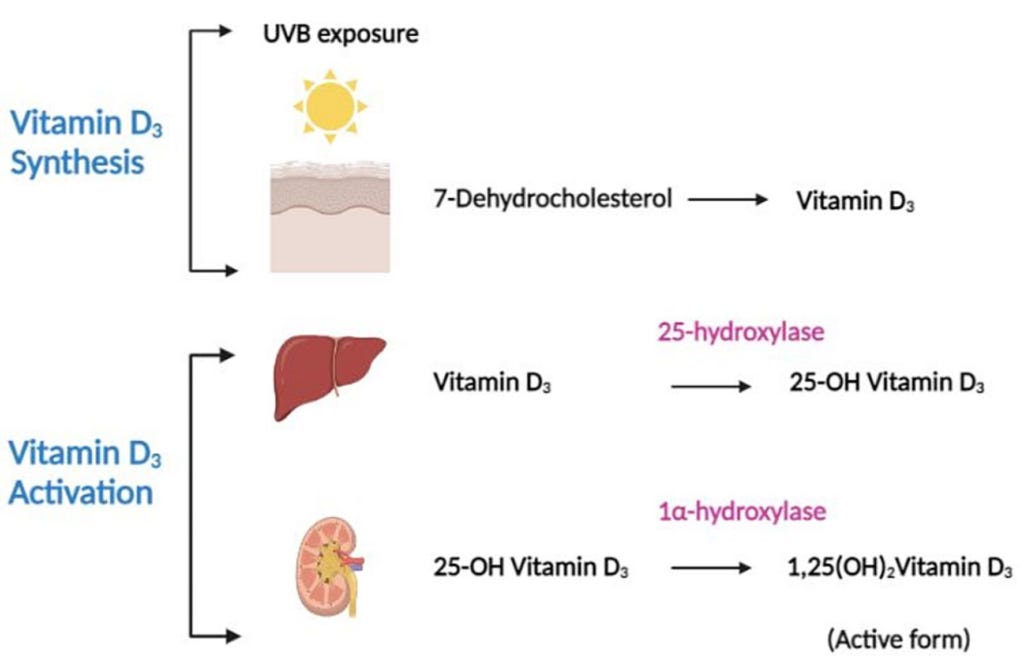
Some important points:
Vitamin D supplements contain cholecalciferol (or more rarely ergocalciferol [vitamin D2], the form of calciferol produced by plants, yeasts and fungi), but cholecalciferol is not biologically active until it has undergone the conversion processes in the liver and kidneys, described above.
25-hydroxyvitamin D3 is the major circulating form of vitamin D, and is what is measured when your doctor orders a "vitamin D blood test". But 25-hydroxyvitamin D3 is the storage form of vitamin D, and is not biologically active.
Only the final product of all these biochemical reactions, 1,25-dihydroxycholecalciferol, or calcitriol, is the biologically active form, which carries out the functions attributed to vitamin D (which I'll get to in part 2).
There are two major prerequisites for synthesis of vitamin D via solar irradiation of our skin:
1. The sunlight must have direct contact with our skin.
That is,
Our skin must not be covered by clothing. Even regular street clothing prevents the photoproduction (i.e. production stimulated by sunlight) of previtamin D3 and the elevation of serum vitamin D3. Religious modesty garments that cover the face and body, completely preclude vitamin D synthesis.
The sunlight must not be filtered through window glass, plexiglas or plastic, all of which block the UVB radiation that is necessary for vitamin D synthesis and prevent previtamin D3 formation from 7-dehydrocholesterol.
The sunlight must not be blocked by clouds; heavy cloud cover reduces UVB radiation by up to 99 per cent. Broken clouds, on the other hand, can enhance UVB radiation by up to 50 per cent.
The sunlight must not be obscured by air pollution, especially nitrous oxide, sulphur dioxide and ozone which absorb solar UVB radiation.1
2. The sun must be high enough in the sky to stimulate previtamin D formation.
The vast majority of UVB radiation emitted by the sun - upwards of 99 per cent of it, in fact - is absorbed by the stratospheric ozone layer before it ever reaches the earth's surface.
Going out in the early morning or late afternoon is useless for vitamin D synthesis, because when the sun is lower in the sky, its rays pass through the stratosphere at a lower angle, resulting in more trapping of UVB by stratospheric ozone. In practice, this means that significant vitamin D production is possible only between 10 am and 3 pm even in the summer time, with production peaking at noon (or 1 pm in regions that observe daylight saving time).
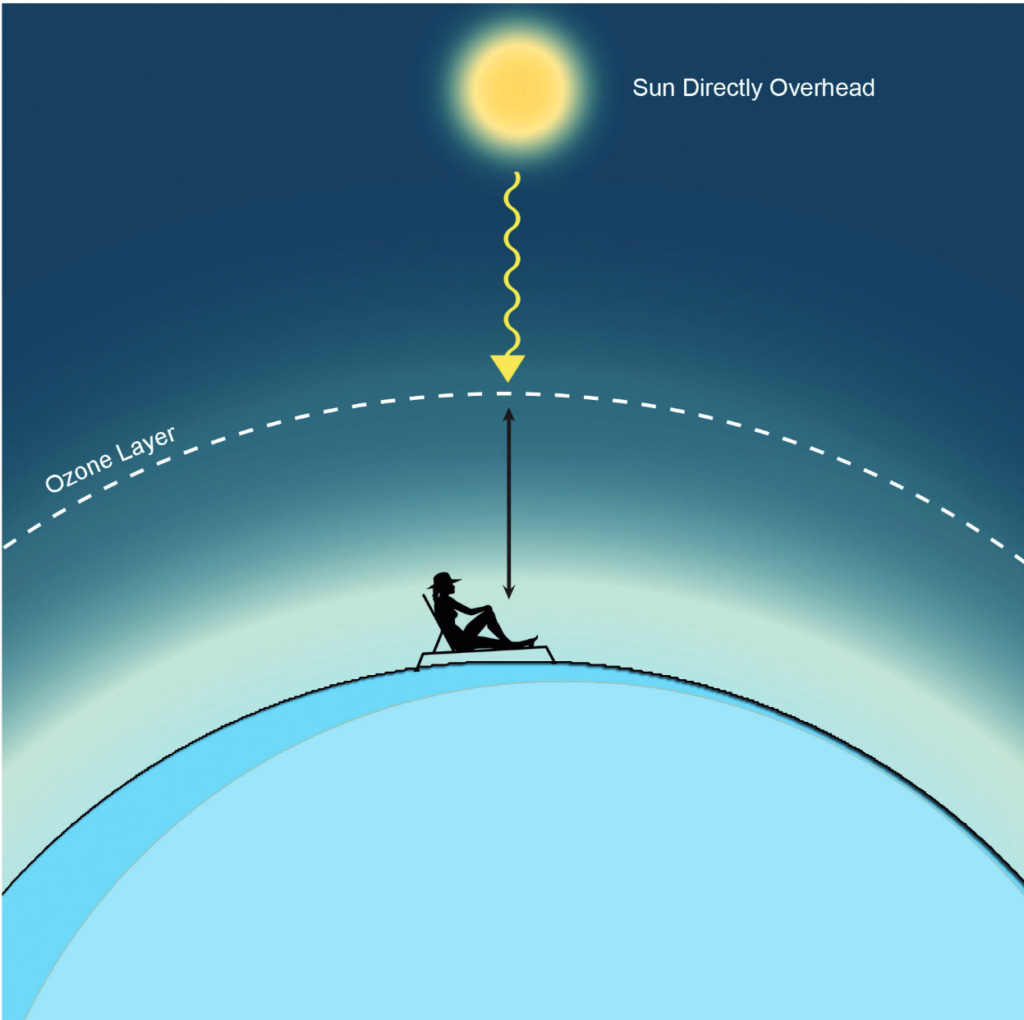
To stimulate adequate vitamin D production, the sun must be at least 45° above the horizon.
UVB radiation is most intense at the equator and slowly diminishes with increasing latitude (distance from the equator). At high latitudes (i.e. closer to the north and south poles), during the winter months the sun remains quite low in the sky even at noon, and hence almost no UVB radiation reaches the earth's surface. If you live above 33° N or below 33° S, your capacity to produce vitamin D from sun exposure during winter is very limited, and above or below 50° N or S, you'll be essentially unable to produce vitamin D for about six months out of every year.
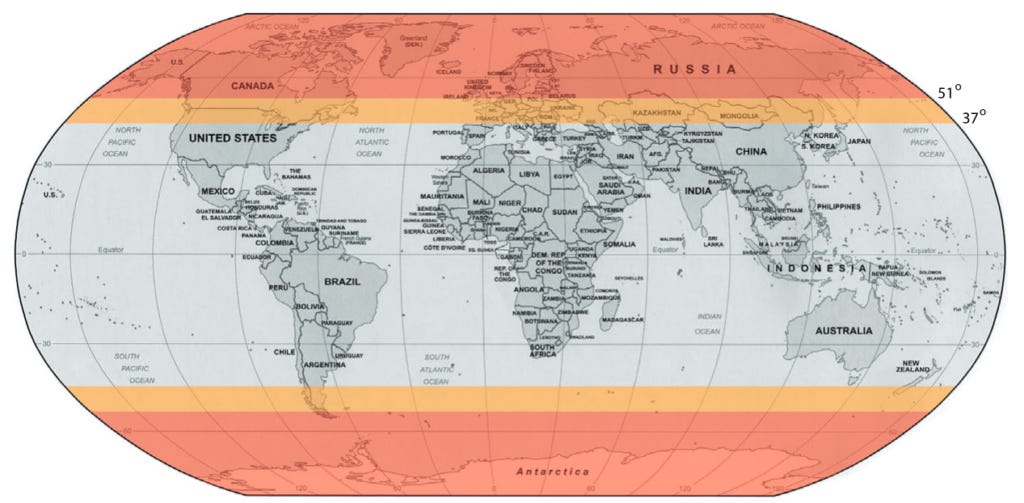
The rule of thumb is that if your shadow is longer than you are tall, there is insufficient UVB for you to produce vitamin D through sunlight exposure to your skin.
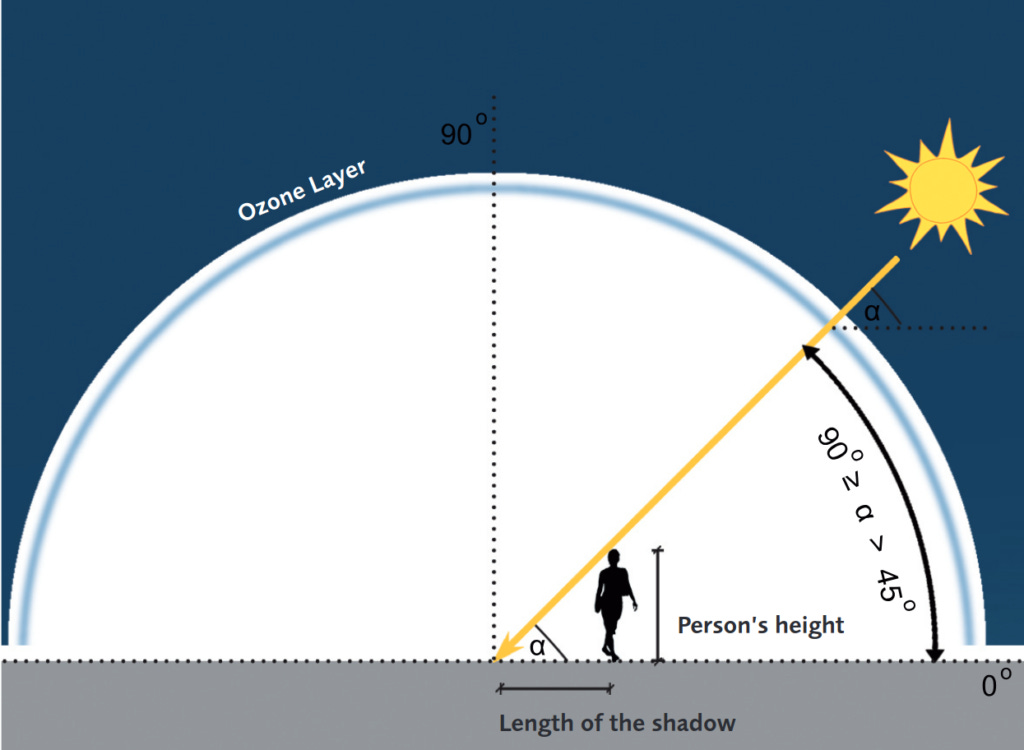
Even at latitudes at which vitamin D production in skin can occur year-round, the rate of production varies enormously depending on the season, because of the changing angle of the sun as distance from the equator increases. For example, a study comparing vitamin D synthesis in two Brazilian cities - Fortaleza, which is just 3 degrees south of the equator, and Sao Paolo which is 23° S - found that conversion of 7-dehydrocholesterol to vitamin D3 was over 50 per cent lower during the winter period in Sao Paolo than in Fortaleza.
Other factors affecting vitamin D production
Altitude
At higher altitudes, there is less atmosphere to trap UVB, leading to greater vitamin D production. For example, the Indian city of Agra and the Mt Everest base camp are located at the same latitude (27° N), but vastly different altitudes. Previtamin D3 production has been shown to be almost 5-fold higher at Mt Everest base camp (5300 m above sea level) than in Agra (169 m).
Obesity
Being fat-soluble, vitamin D is sequestered in fat tissue. There is an inverse association between body mass index and serum 25-hydroxyvitamin D concentration. That is, the higher the body fat percentage, the lower the vitamin D level, and the lower the response to either UVB exposure or vitamin D supplementation:

In the past, food was scarce during the winter in higher latitude regions, so humans were partly living off the body fat reserves they had built up when calories were plentiful. As their fat stores broke down, the vitamin D that had accumulated in adipose tissue during summer and autumn was released into circulation. But now, those lean days of winter never come, and most people stay overfat all year... with their vitamin D stores inaccessible during the very time of year when they're most needed, to compensate for lack of sun exposure.
In addition to fat sequestering, the other major reason why obese people have lower vitamin D levels is that they tend to have chronic low-grade inflammation. More on this in a subsequent part of this miniseries.
I have seen many overweight and obese clients over the years, whose serum 25-hydroxyvitamin D remains stubbornly low despite regular supplementation. Very few of them have been told that they would need three to five times as much vitamin D as a healthy-weight person to achieve a 25-hydroxyvitamin D level in the non-deficient range. And even fewer have been told that if they lost weight, their level would most probably normalise without any supplementation.
Age
7-dehydrocholesterol concentrations in the epidermis are inversely related to age:

When exposed to the same amount of UVB, the increase in blood level of vitamin D3 in young adults aged 20–30 was at least three-fold higher compared with older adults aged 62–80.
Declining kidney function in aging adults also reduces the production of calcitriol, which you'll recall is the biologically active form of vitamin D.
Yet while older people require more sunlight exposure to produce sufficient vitamin D, most spend considerably less time outdoors than in their youth - especially if they live in residential care facilities, which often either lack outdoor areas, or the staff to escort residents to them.
The skin you're in
One of the most significant biological modulators of vitamin D synthesis rates is melanin, the pigment in our skin (and also our hair and eyes). Humans evolved in equatorial regions, which are sun-drenched all year round - and, as mentioned previously, UVB radiation levels are highest at the equator. Melanin acts as an effective sunscreen by absorbing most solar UVB radiation, while still permitting a small amount of UVB to penetrate into the epidermis to produce vitamin D.
As our ancient ancestors migrated out of Africa into progressively higher latitudes, natural selection favoured the survival of those whose skin produced less melanin, allowing them to synthesise more vitamin D in response to the reduced and more sporadic availability of UVB radiation. In every population studied, females have been found to be lighter-skinned than males, presumably to meet the greater demand for synthesis of vitamin D during pregnancy and lactation.
The further north they ventured, the less heavily pigmented humans became, culminating with the development of the fair-skinned Celts, whose pale flesh burns easily, but never tans.
The Fitzpatrick skin type classification, illustrated in the table below, strongly correlates with the latitude from which the ethnic groups bearing these skin types originate. Skin types 5 and 6 represent the 'original version' of human beings, who evolved in the tropics (0° to 23°) and subtropics (23° to 35°). The ancestors of people with skin types 3 and 4 hail from the mid latitudes (35° to 50°), whereas those with skin types 1 and 2 are the descendants of humans who pushed through to the high latitudes (50° to 70°), which have minimal UVB exposure all year round.

While ancient migrations took place slowly, permitting gradual adaptation to altered UVB availability over many generations, in the modern era humans can relocate rapidly to regions whose light environments are wildly different to those to which they're adapted. Australia was colonised by freckle-faced Celts and other fair-skinned denizens of Britain and northern Europe, whose type I and II skin is entirely unsuited to the intensity of UVB radiation on this continent. Conversely, people from Africa and the Indian subcontinent have migrated to North America, the UK and Europe, where their type V and VI skin makes it virtually impossible to produce sufficient vitamin D.
In fact, it takes between 10 and 50 times as much exposure to sunlight for a person with Fitzpatrick type V or VI skin to produce as much vitamin D as a person with type II or III. Take another look at the world map depicting latitude, UVB intensity and vitamin D production capacity, and you'll get some sense of the sheer scale of this evolutionary mismatch, in an era of mass migration.
What about sunscreen use?
Although studies conducted in the 1980s found that long-term daily users of sunscreen had significantly lower blood levels of vitamin D, more recent studies of the use of sunscreens in real-life settings have either found no decrease in 25-hydroxyvitamin D concentrations associated with self-reported regular use, or even increased concentrations (probably because people take sunscreen use as a "permission slip" to stay out in the sun for longer than is advisable, given their skin type, and they rarely apply as much as is recommended). However, there is inadequate evidence regarding the impact on vitamin D levels of very high sun protection factor sunscreens.
Can we cheat the system?
Is there any difference in biological activity between vitamin D that's produced via sunlight exposure, and vitamin D that's consumed as a supplement, or in foods that naturally contain it such as fatty fish, fish liver oils and certain types of mushrooms? Yes, without a doubt.
For starters, it takes about eight hours for precalciferol in the skin to fully convert into cholecalciferol (vitamin D3), and further time for the cholecalciferol to diffuse into the skin's capillary bed from whence it enters the general circulation.
There are also marked differences in how vitamin D that's made in the skin is transported around the body, vs vitamin D that is taken orally, either through supplementation or food (including fortified foods). Whereas all of the vitamin D produced through UVB irradiation travels through the circulation bound to vitamin D binding protein (DBP), only about 60 per cent of ingested vitamin D is bound to DBP, with the remaining 40 per cent bound to lipoproteins (including low density lipoprotein, or LDL), which are rapidly cleared from circulation.
Hence, the circulating level of cholecalciferol remains elevated for two to three times longer after sun exposure, than after taking a vitamin D supplement. That is, you get a longer-lasting boost in vitamin D levels from sun exposure than from supplementation.
Furthermore, there is concern that diet-derived vitamin D, carried into arterial walls on LDL particles, may promote the calcification of atherosclerotic plaque.
But perhaps the most impactful difference between making vitamin D via your skin and taking it as an oral supplement or in foods, is that UVB irradiation of the skin only converts approximately 15 per cent of 7-dehydrocholesterol to previtamin D, because any further exposure to UVB causes the previtamin D to isomerise (change its chemical arrangement) into two other photoproducts, lumisterol3 and tachysterol3, or to convert back into 7-hydroxycholesterol. Likewise, once vitamin D is formed within the skin, any further exposure to UVB will drive its conversion into several other steroidal structures which have no vitamin D activity.
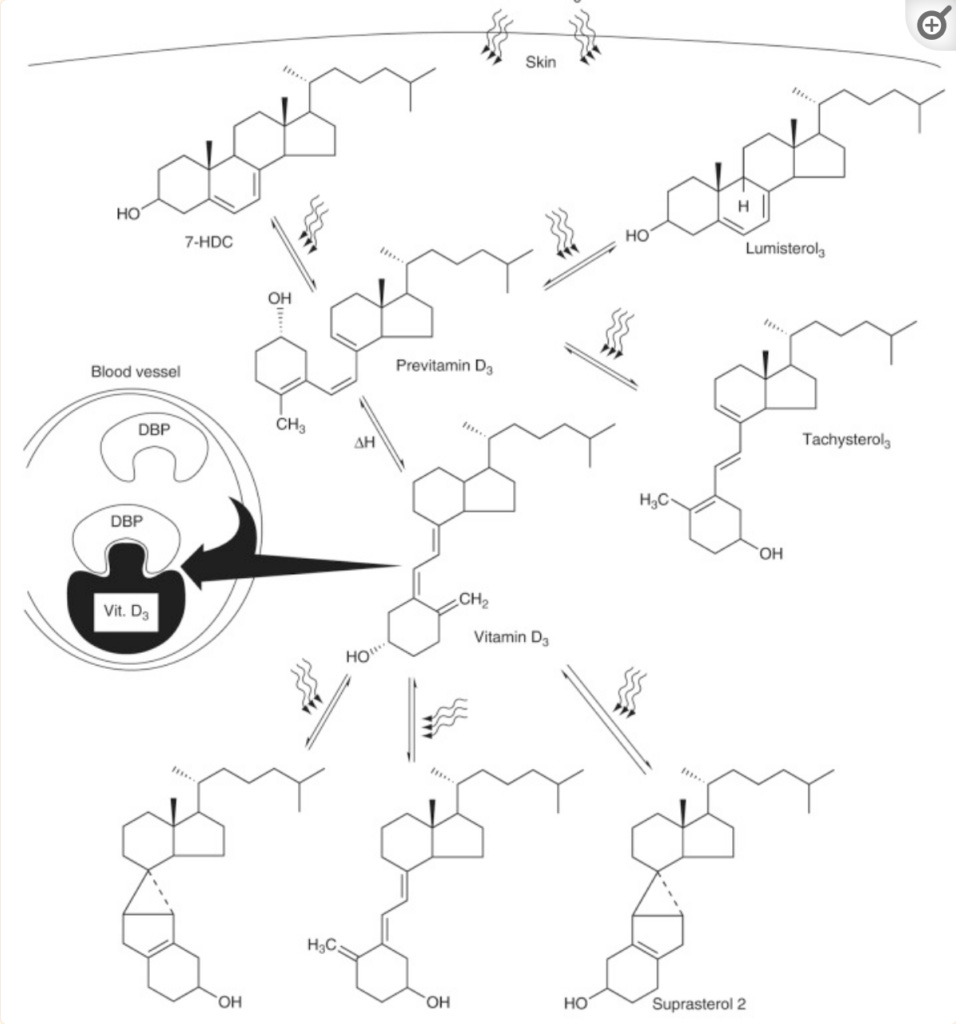
Thus, the maximum amount of vitamin D that can be produced from a bout of sunlight exposure is 20 000 international units (IU), and it is impossible to ever reach a toxic level of vitamin D from sun exposure, because there is an in-built brake on overproduction of vitamin D known as photoequilibrium. (In contrast, vitamin D intoxication from supplements is well-documented, as will be discussed in a subsequent part of this miniseries.)
And even more importantly, while the nonvitamin D protoproducts do not carry out the major biological activity of vitamin D - regulating calcium metabolism - they do have beneficial biological effects. For example, lumisterol3 can be converted to 1,25-dihydroxylumisterol3 which may have anti-tumour effects in the skin, and some of the suprasterols formed when vitamin D3 is irradiated by UVB, have antiproliferative effects in keratinocytes (the primary cell type found in the epidermis, the outermost layer of the skin).
Just to ram home the crucial point, these protective effects of nonvitamin D photoproducts are not gained from taking a vitamin D supplement. And for that matter, none of the other benefits of going out in the sun, such as nitric oxide and β-endorphin production in the skin, and circadian rhythm regulation, are obtained from vitamin D supplements. But that's a topic for another post... or perhaps another miniseries!
In the next post, I'll be digging into the many biological activities of not-a-vitamin-but-a-steroid-hormone 'vitamin D'. In the mean time, I’d love to get your feedback on which aspects of the vitamin D story interest you the most:
And finally, this post has taken me approximately 20 hours to research and write (and I’m just getting started on this vitamin D deep dive!). I make all my posts freely available to all readers, because I believe we all deserve access to information that helps us to take greater control over our health. But I rely on my small core of paid subscribers to provide this service to those who genuinely can’t afford it.
For information on my private practice, please visit Empower Total Health. I am a Certified Lifestyle Medicine Practitioner, with an ND, GDCouns, BHSc(Hons) and Fellowship of the Australasian Society of Lifestyle Medicine.
It's no surprise that the bone deforming disease rickets, typically described as a vitamin D deficiency disorder, became widespread in the UK and northern Europe after the industrial revolution drove rapid urban expansion, leading to dense air pollution from coal burning, and overcrowded residential areas in which many people were deprived of any sun exposure. The Polish doctor Jędrzej Śniadecki was already curing children afflicted with rickets by exposing them to sunlight, in 1822.
The classic bone deformities of rickets were first described, however, by 1st and 2nd century AD Greek and Roman physicians, including Galen.







Extremely interesting Robyn! My take away from this is as follows:
being fair skinned, self employed and living in a beach side suburb of Sydney, I'm lucky and have the opportunity to get adequate sun exposure. (I'd hate to be dark skinned and living somewhere like northern Europe as it seems a real health hazard) I wonder if this partly explains the generally poorer health of black Americans given many live in a climate not suited to dark skin and have no hope of ever getting sufficient sun exposure and probably being chronically deficient in Vitamin D.
Given that the situation seems to be that Vit D supplementation is very unlikely to be as good as sunlight, potentially carries risks and that food sources can't supply it, I'll prioritise sensible sun exposure, cover sun damaged skin such as forearms, avoid sunscreens, not shower or swim for at least 3 hrs after sun exposure.
If my labs show levels under say 65 nmol/L I'll review and consider supplements.
My concern with supplements though, is (apart from not trusting their contents are what they are supposed to be) they may cause the body to shutdown endogenous production of Vit D if it perceives levels are adequate and then I'd be reliant on the inferior supplemental form ongoing. (sure, a great business model for industry)
How does one deal with periods of extended wet and cloudy weather as Sydney has experienced in the last 4 years or so?
Another fantastic article Robyn, well worth the paid subscription!
I’m interested in what level of benefit comes from us being exposed to the full spectrum of light when we get sunlight and whether we fully understands this process yet, as opposed to the analysis of the individual spectrums?
And, do IR saunas provide similar benefits?
Thanks again